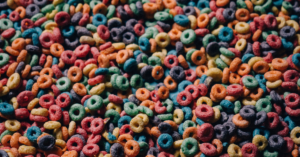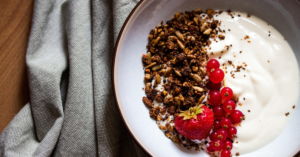
Fruit Loops Nutrition Information – Unveiling the Delicious Truth
Dive into the world of Fruit Loops nutrition information with our comprehensive guide. Discover the facts, myths, and everything you need to know about this colorful cereal.
Fruit Loops Nutrition Information

Are you a fan of the colorful and delicious Fruit Loops cereal? You’re not alone! This vibrant cereal has been a breakfast favorite for many. However, have you ever wondered about the nutritional aspects of this delightful treat? In this article, we’ll delve into the fascinating world of Fruit Loops nutrition information, uncovering the facts behind this iconic cereal.
The Origin of Fruit Loops
Fruit Loops, those colorful cereal rings, were born in the early 1960s thanks to Don Low, a food scientist at Kellogg Company. Don’s goal was to create a visually appealing and uniquely flavored cereal.
Fruit Loops made their debut in 1963, setting a new standard for breakfast cereals with their vibrant colors and distinctive fruity taste, a fusion of orange, lemon, and cherry.
These delightful rings quickly became a breakfast favorite and have continued to brighten mornings with their colorful charm. The iconic mascot, Toucan Sam, further cemented their popularity.
Fruit Loops are not just a cereal; they’re a symbol of creativity and innovation in the food industry, making breakfasts more enjoyable for generations.
The Nutritional Breakdown
Now, let’s delve even deeper into the Fruit Loops Nutrition Information. Understanding the specific nutrients in this cereal can help you make informed decisions about your diet.
Calories
Fruit Loops are a popular choice for breakfast, and many people wonder about their calorie content. A typical serving of Fruit Loops, which is about 1 cup, contains approximately 110 calories. These calories come from a combination of carbohydrates, protein, and a small amount of fat. Let’s delve into the Fruit Loops nutrition information, specifically the calorie content.
- Carbohydrates: The majority of the calories in Fruit Loops come from carbohydrates. This cereal is a significant source of energy due to its high carbohydrate content. It’s important to note that these carbohydrates primarily come from sugar and refined grains. While this provides a quick energy boost, it’s not the most nutritionally ideal source of carbs.
- Protein: Fruit Loops contain a small amount of protein, around 1-2 grams per serving. Protein is essential for building and repairing tissues in the body, but this cereal is not a significant source of it. To make your breakfast more balanced, consider adding a protein source like milk or yogurt.
- Sugars: One of the most contentious aspects of Fruit Loops is their sugar content. A single serving can contain up to 12 grams of sugar, which is considerably high for a breakfast cereal.
- Fat: Fruit Loops have a minimal amount of fat, usually less than 1 gram per serving. The fat content in this cereal is negligible, making it a low-fat option.
- Vitamins and Minerals: Fruit Loops are often fortified with vitamins and minerals to boost their nutritional value. Common additions include vitamins like B vitamins, vitamin D, and minerals like iron. These fortifications aim to address the nutrient deficiencies that can occur with a diet high in sugary cereals.
Vitamins and Minerals
Fruit Loops nutritional information mainly consists of essential vitamins and minerals:
- Vitamin A: They provide a small amount of vitamin A, which is important for eye health.
- Vitamin C: Fruit Loops contain a small percentage of vitamin C, contributing to your daily intake.
- Iron: Iron is crucial for blood health, and Fruit Loops provide a modest amount.
- Calcium: Calcium, important for strong bones, is also found in Fruit Loops.
The Truth About Ingredients
A closer look at the ingredient list of Fruit Loops nutrition reveals some interesting facts. While the cereal may be visually enticing, it contains ingredients that are not as wholesome as they may seem:
- Sugar: As mentioned earlier, Fruit Loops are loaded with sugar. This is not the kind of sweetness that comes from real fruit; it’s added sugar to enhance taste.
- Artificial Colors: The vivid colors of Fruit Loops are achieved through the use of artificial food dyes. Some studies have suggested potential links between these dyes and hyperactivity in children.
- Artificial Flavors: Fruit Loops get their fruity flavors from a combination of natural and artificial flavorings. While natural flavors are derived from real food sources, artificial flavors are created synthetically.
- BHT: Butylated hydroxytoluene (BHT) is a synthetic antioxidant used to preserve the freshness of the cereal. Its presence has raised concerns about potential health risks.
Fruit Loops for Breakfast
Fruit Loops are a classic choice for breakfast. Many people, especially kids, adore the bright colors and fruity flavors. If you’re looking to make Fruit Loops a part of your breakfast routine, here are some tips:
- Balance is Key: As we’ve discussed, Fruit Loops are not the most nutritious choice by themselves. To make your breakfast more balanced, consider adding a source of protein, such as yogurt, and some fresh fruit. This can increase the overall nutritional value of your meal.
- Watch Portion Sizes: It’s easy to pour a large bowl of Fruit Loops, but be mindful of portion sizes. A recommended serving size is around 1 cup, which is typically less than you might pour into a typical cereal bowl. Overeating can lead to excess calorie and sugar intake.
- Whole Milk or Dairy Alternatives: Consider using whole milk or dairy alternatives like almond or soy milk. These can add creaminess and flavor while providing some healthy fats and protein.
A Delectable Snacking Choice
Fruit Loops aren’t limited to breakfast; they also make a delicious and colorful snack. Many people enjoy them as a snack. There are endless creative ways to enjoy them beyond the breakfast bowl. Get ready for a burst of flavor and fun with Fruit Loops as a delightful snack option.
Fruit Loops and Weight Management
If you’re watching your weight, consuming Fruit Loops in moderation is key. The high sugar content can lead to unwanted weight gain if not managed.
Are Fruit Loops Healthy?
This is a million-dollar question, and it’s essential to address it from multiple perspectives.
Fruit Loops have both positive and negative aspects when it comes to health. Let’s break it down:
The Positives
- Convenience: Fruit Loops are convenient for a quick breakfast. They require no cooking and are ready to eat straight from the box, which can be a time-saver for busy mornings.
- Vitamins and Minerals: Thanks to fortification, Fruit Loops do provide some essential vitamins and minerals. For people who may not have access to a more balanced breakfast, these fortifications can be beneficial.
The Negatives
- High Sugar Content: Perhaps the most significant concern with Fruit Loops is their high sugar content. Many breakfast cereals are loaded with added sugars, and this can contribute to weight gain, blood sugar spikes, and other health problems.
- Lack of Fiber: Fruit Loops are typically low in dietary fiber, which is important for digestive health and feeling full. A low-fiber breakfast may leave you hungry again shortly after eating.
- Artificial Colors and Flavors: These vibrant loops get their eye-catching colors from artificial additives. Some studies have suggested that artificial food dyes may be linked to hyperactivity in children.
The Impact of Fruit Loops on Children

While children may love the taste of Fruit Loops, it’s important to monitor their intake due to the high sugar content. Frequent consumption may contribute to dental issues and unhealthy eating habits.
Fruit Loops vs. Other Cereals
How do Fruit Loops stack up against other breakfast cereals? Let’s compare them to some common options:
- Fruit Loops vs. Bran Flakes: Bran flakes are a high-fiber cereal that provides more sustained energy and fullness than Fruit Loops. However, they may not be as appealing to those who crave sweetness in the morning.
- Fruit Loops vs. Oatmeal: Oatmeal is a nutritious choice with heart-healthy fiber. It can be sweetened with natural ingredients like honey or fruit for added flavor.
- Fruit Loops vs. Corn Flakes: Corn flakes are another popular cereal choice. They have a similar texture to Fruit Loops but are lower in sugar.
Expanding on these comparisons, we can see that while Fruit Loops have their appeal, there are more nutritious options available. However, your choice ultimately depends on your taste preferences and dietary goals.
The Importance of Moderation
As we already discussed in the section on Fruit Loops Nutrition Information, let us now talk about moderation. It’s important to note that enjoying Fruit Loops occasionally is not inherently harmful. The key is moderation. An occasional treat can be a fun addition to your breakfast routine, but it should not be a daily staple. A more balanced approach to breakfast would involve incorporating a variety of whole foods like fruits, vegetables, whole grains, and protein sources.
Alternatives to Consider

If you’re looking for a healthier alternative to Fruit Loops that’s still kid-friendly, consider the following options:
- Oatmeal: Oatmeal is a nutritious and filling choice. You can add fruits and a touch of honey for natural sweetness.
- Whole Grain Cereals: Look for cereals with whole grains and lower sugar content. You can always add fresh fruit for a natural burst of flavor.
- Greek Yogurt with Berries: Greek yogurt is rich in protein and pairs well with fresh berries for a delicious and healthy breakfast.
- Smoothies: Blend fruits, vegetables, and protein sources like yogurt or protein powder to create a nutrient-packed morning smoothie.
In Conclusion
Fruit Loops are undoubtedly delicious and visually captivating, making them a beloved breakfast choice for many. However, it’s essential to be aware of their nutritional content, which includes high sugar levels and artificial additives. Enjoying Fruit Loops in moderation as an occasional treat is fine, but they should not be a regular part of your breakfast routine. A balanced breakfast that includes a variety of whole foods is the key to starting your day on the right foot, ensuring a healthier and more energetic beginning. So, when it comes to Fruit Loops, remember to savor the delicious truth with a dash of caution.
FAQs
Q1. Are Fruit Loops suitable for a weight loss diet?
Fruit Loops should be consumed in moderation if you’re aiming to lose weight due to their high sugar content.
Q2. Are there any healthier alternatives to Fruit Loops?
Yes, consider whole-grain cereals, oatmeal, or yogurt with fresh fruit for a healthier breakfast.
Q3. Can Fruit Loops be part of a child’s diet?
While children may enjoy Fruit Loops, parents should monitor their consumption due to the high sugar content.
Q4. Do Fruit Loops provide any nutritional benefits?
They provide some essential vitamins and minerals, but their high sugar content is a drawback.
Q5. How can I make Fruit Loops healthier?
To make Fruit Loops healthier, consider consuming smaller portions and mixing them with a cereal higher in fiber.




